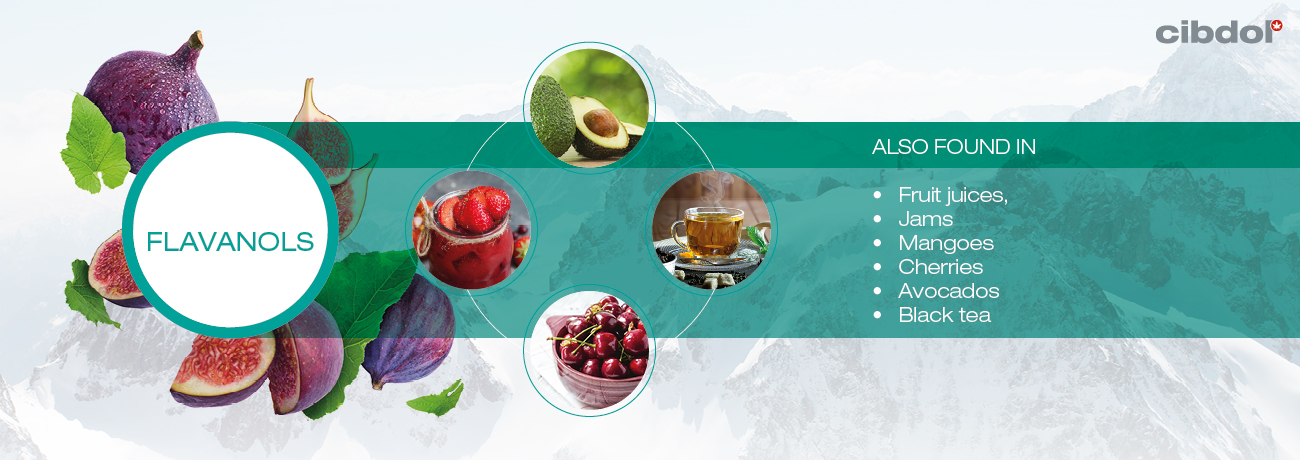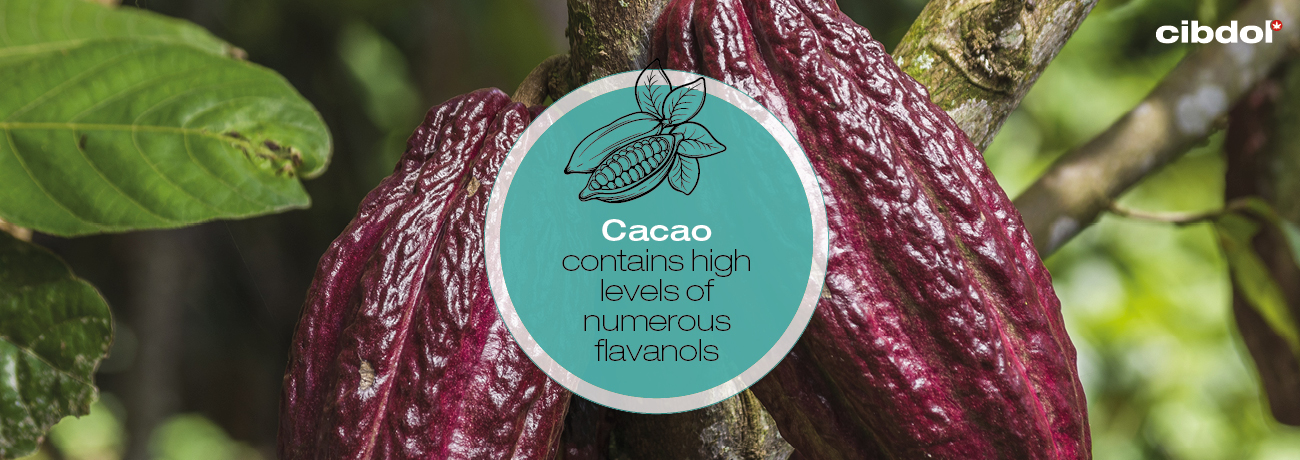What Are Flavanols?
Flavanols are a subclass of a larger group of chemicals known as flavonoids. Flavonoids as a whole are found in a wide variety of species and are purported[1] to contribute to the health benefits of these food groups. A class of flavanols known as catechins are thought to contribute to the antioxidant and cardioprotective[2] effects of popular health foods and drinks.
Plants synthesise flavanols as secondary metabolites. They don’t contribute towards reproduction and development, but they might help certain species deal with environmental stress. Flavanols likely exert antioxidant and protective effects[3] in plants, although their exact role remains unclear.
Colour
Unlike their close relatives—anthocyanins and flavanones—flavanols are completely colourless[4]. When extracted, these molecules form a condensed, colourless liquid.
Also found in

Flavanols occur in various popular fruits and food and drink items. They mostly occur within the peels and seeds of fruits and vegetables, as opposed to the flesh.
Flavanols can be found[5] in relatively high amounts in fruit juices, jams, apples, avocados, figs, mangoes, strawberries, cacao, cherries, black tea, green tea, red wine, white wine, and port wine.
Flavanol intake will vary based on diet, but research indicates an average intake of around 50mg per day in parts of Europe.
Supporting research
Early research shines a light on the potential therapeutic effects of flavanols. They haven’t received as much attention as other members of the chemical class, but limited research has thus far produced some promising results.
• Heart health
Catechins, a type of flavonoid, might benefit cardiovascular health, in part due to their anti-inflammatory and antioxidant effects.
The primary catechin found within green tea, epigallocatechin gallate (EGCG), might decrease vascular inflammation[6] by inhibiting nitric oxide generation. Less NO can help to decrease endothelial exocytosis.
Endothelial cells line the inner surface of blood vessels. Exocytosis occurs when granules from these cells fuse to the plasma membrane. This results in the release of pro-inflammatory proteins that contribute to vascular inflammation—a precursor state of atherosclerosis (hardening of the arteries).
Further research has confirmed the NO-inhibiting effects of flavanols. Research[7] published in the Journal of Hypertension tested the effects of flavanol-rich cocoa on vasodilation in healthy subjects.
Cacao—the main component of chocolate—contains high levels of numerous flavanols, including epicatechin, catechin, and procyanidin oligomers. Researchers gave the subjects a total of 821mg of cocoa each day. During the five-day trial, they found the cocoa to induce consistent and striking peripheral dilation of blood vessels. This suggests that flavanol-rich foods might help protect against coronary events, including heart attacks.

• Antioxidant activity
Thanks to their antioxidant activity, flavanols found in green tea might help to curb oxidative stress. Oxidative stress stems from numerous factors, including pollution, diet, and exposure to chemicals. These events can contribute to an imbalance between free radicals and the body's ability to neutralise them.
Free radicals—toxic byproducts of oxygen metabolism—can cause significant damage to cells, and underpin many different chronic conditions.
Green tea flavanols have displayed antioxidant activity in cell studies. Antioxidants achieve their effects by donating an electron to free radical molecules—stopping or reducing oxidative damage. The green tea flavanols EGCG and EGC can donate an electron without using much energy. This makes their ability to scavenge free radicals superior to that of famed antioxidant vitamin E.
• Neuroprotection and cognitive performance
A review[8] in the Journal of Cardiovascular Pharmacology suggests that flavanols might help to stave off cognitive disease. The mechanism might lie in their ability to increase blood flow to the brain.
Human research[9] has shown that a one-week treatment of flavanol-rich cocoa (900mg per day) elevated cerebral blood flow in grey matter and reversed endothelial dysfunction. These results hint at the neuroprotective effects of flavanols, as cognitive decline and dementia are linked to reduced cerebral blood flow[10].
As well as helping to protect the brain, flavanols might also enhance the organ’s performance. A review[11] published in Frontiers in Nutrition details the effects of cocoa flavanols on cognitive function, suggesting that short-term consumption appears to increase memory and reaction time, whereas long-term consumption may help “increase[sic] neural efficiency”.
Safety and side effects
Consumption of up to 2000mg of cocoa flavanols per day for 12 weeks appears to be safe in healthy people[12]. However, sources of flavanols—cacao and tea—contain stimulating molecules such as caffeine. High consumption of these sources could lead to caffeine-related side effects such as nausea, nervousness, insomnia, and increased heart rate.
[1] de Pascual-Teresa, S., Moreno, D. A., & García-Viguera, C. (2010). Flavanols and Anthocyanins in Cardiovascular Health: A Review of Current Evidence. International Journal of Molecular Sciences, 11(4), 1679–1703. https://doi.org/10.3390/ijms11041679 [Source]
[2] Higdon, J. V., & Frei, B. (2003). Tea Catechins and Polyphenols: Health Effects, Metabolism, and Antioxidant Functions. Critical Reviews in Food Science and Nutrition, 43(1), 89–143. https://doi.org/10.1080/10408690390826464 [Source]
[3] Samanta, A., Das, G., & Das, S. K. (2011, January 1). Roles of flavonoids in Plants. ResearchGate. https://www.researchgate.net/publication/279499208_Roles_of_flavonoids_in_Plants [Source]
[4] Das, A. B., Goud, V., & Das, C. (2019). Phenolic Compounds as Functional Ingredients in Beverages. Value-Added Ingredients and Enrichments of Beverages, 285–323. https://doi.org/10.1016/b978-0-12-816687-1.00009-6 [Source]
[5] Hollman, P. C., & Arts, I. C. (2000). Flavonols, flavones and flavanols – nature, occurrence and dietary burden. Wiley Online Library. Published. https://onlinelibrary.wiley.com/doi/abs/10.1002/(SICI)1097-0010(20000515)80:7%3C1081::AID-JSFA566%3E3.0.CO;2-G [Source]
[6] Lin, Y. L., & Lin, J. K. (1997). Epigallocatechin-3-gallate blocks the induction of nitric oxide synthase by down-regulating lipopolysaccharide-induced activity of transcription factor nuclear factor-kappaB. PubMed. Published. https://pubmed.ncbi.nlm.nih.gov/9281609/ [Source]
[7] Fisher, N., Hughes, M., & Gerhard-Herman, M. (2003). Flavanol-rich cocoa induces nitric-oxide-dependent vasodilation in healthy humans. Journal of Hypertension. Published. https://journals.lww.com/jhypertension/Abstract/2003/12000/Flavanol_rich_cocoa_induces_nitric_oxide_dependent.16.aspx [Source]
[8] Fisher, N., Sorond, F., & Hollenberg, N. (2006). Cocoa Flavanols and Brain Perfusion. Journal of Cardiovascular Pharmacology. Published. https://journals.lww.com/cardiovascularpharm/Fulltext/2006/06001/Cocoa_Flavanols_and_Brain_Perfusion.17.aspx [Source]
[9] Nehlig, A. (2013). The neuroprotective effects of cocoa flavanol and its influence on cognitive performance. NCBI. Published. https://doi.org/10.1111/j.1365-2125.2012.04378.x [Source]
[10] Leeuwis, A. E., Smith, L. A., & Melbourne, A. (2018). Cerebral Blood Flow and Cognitive Functioning in a Community-Based, Multi-Ethnic Cohort: The SABRE Study. NCBI. Published. https://doi.org/10.3389/fnagi.2018.00279 [Source]
[11] Socci, V., Tempesta, D., Desideri, G., de Gennaro, L., & Ferrara, M. (2017). Enhancing Human Cognition with Cocoa Flavonoids. Frontiers in Nutrition, 4. https://doi.org/10.3389/fnut.2017.00019 [Source]
[12] Ottaviani, J. I., Balz, M., Kimball, J., Ensunsa, J. L., Fong, R., Momma, T. Y., Kwik-Uribe, C., Schroeter, H., & Keen, C. L. (2015). Safety and efficacy of cocoa flavanol intake in healthy adults: a randomized, controlled, double-masked trial. The American Journal of Clinical Nutrition, 102(6), 1425–1435. https://doi.org/10.3945/ajcn.115.116178 [Source]
[1] de Pascual-Teresa, S., Moreno, D. A., & García-Viguera, C. (2010). Flavanols and Anthocyanins in Cardiovascular Health: A Review of Current Evidence. International Journal of Molecular Sciences, 11(4), 1679–1703. https://doi.org/10.3390/ijms11041679 [Source]
[2] Higdon, J. V., & Frei, B. (2003). Tea Catechins and Polyphenols: Health Effects, Metabolism, and Antioxidant Functions. Critical Reviews in Food Science and Nutrition, 43(1), 89–143. https://doi.org/10.1080/10408690390826464 [Source]
[3] Samanta, A., Das, G., & Das, S. K. (2011, January 1). Roles of flavonoids in Plants. ResearchGate. https://www.researchgate.net/publication/279499208_Roles_of_flavonoids_in_Plants [Source]
[4] Das, A. B., Goud, V., & Das, C. (2019). Phenolic Compounds as Functional Ingredients in Beverages. Value-Added Ingredients and Enrichments of Beverages, 285–323. https://doi.org/10.1016/b978-0-12-816687-1.00009-6 [Source]
[5] Hollman, P. C., & Arts, I. C. (2000). Flavonols, flavones and flavanols – nature, occurrence and dietary burden. Wiley Online Library. Published. https://onlinelibrary.wiley.com/doi/abs/10.1002/(SICI)1097-0010(20000515)80:7%3C1081::AID-JSFA566%3E3.0.CO;2-G [Source]
[6] Lin, Y. L., & Lin, J. K. (1997). Epigallocatechin-3-gallate blocks the induction of nitric oxide synthase by down-regulating lipopolysaccharide-induced activity of transcription factor nuclear factor-kappaB. PubMed. Published. https://pubmed.ncbi.nlm.nih.gov/9281609/ [Source]
[7] Fisher, N., Hughes, M., & Gerhard-Herman, M. (2003). Flavanol-rich cocoa induces nitric-oxide-dependent vasodilation in healthy humans. Journal of Hypertension. Published. https://journals.lww.com/jhypertension/Abstract/2003/12000/Flavanol_rich_cocoa_induces_nitric_oxide_dependent.16.aspx [Source]
[8] Fisher, N., Sorond, F., & Hollenberg, N. (2006). Cocoa Flavanols and Brain Perfusion. Journal of Cardiovascular Pharmacology. Published. https://journals.lww.com/cardiovascularpharm/Fulltext/2006/06001/Cocoa_Flavanols_and_Brain_Perfusion.17.aspx [Source]
[9] Nehlig, A. (2013). The neuroprotective effects of cocoa flavanol and its influence on cognitive performance. NCBI. Published. https://doi.org/10.1111/j.1365-2125.2012.04378.x [Source]
[10] Leeuwis, A. E., Smith, L. A., & Melbourne, A. (2018). Cerebral Blood Flow and Cognitive Functioning in a Community-Based, Multi-Ethnic Cohort: The SABRE Study. NCBI. Published. https://doi.org/10.3389/fnagi.2018.00279 [Source]
[11] Socci, V., Tempesta, D., Desideri, G., de Gennaro, L., & Ferrara, M. (2017). Enhancing Human Cognition with Cocoa Flavonoids. Frontiers in Nutrition, 4. https://doi.org/10.3389/fnut.2017.00019 [Source]
[12] Ottaviani, J. I., Balz, M., Kimball, J., Ensunsa, J. L., Fong, R., Momma, T. Y., Kwik-Uribe, C., Schroeter, H., & Keen, C. L. (2015). Safety and efficacy of cocoa flavanol intake in healthy adults: a randomized, controlled, double-masked trial. The American Journal of Clinical Nutrition, 102(6), 1425–1435. https://doi.org/10.3945/ajcn.115.116178 [Source]







